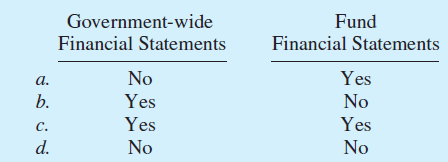Choose the best answer. 1. Which of the following is a special purpose government? a. The State
Question:
1. Which of the following is a special purpose government?
a. The State of Arkansas.
b. Greene County.
c. Minneapolis Public Schools.
d. City of Seattle.
2. Which of the following statements is true for both governmental organizations and for-profit organizations?
a. Lack of a profit motive.
b. Revenue may be earned through exchange transactions.
c. Absence of owners.
d. Resources are provided by individuals and entities that may not directly benefit from the use of the resources.
3. Which of the following statements regarding primary sources of accounting and financial reporting standards is false?
a. The GASB sets standards for all state and local governments.
b. The FASB sets standards for all business and not-for-profit entities.
c. The FASB and GASB are administered by the Financial Accounting Foundation.
d. The FASAB sets standards for the federal government and its agencies and departments.
4. James Black is reviewing his city€™s financial reporting because he wants to run for the city council. He is concerned that the city is not using its resources effectively. James is primarily interested in
a. Fiscal accountability.
b. Social accountability.
c. Political accountability.
d. Operational accountability.
5. The concept of inter period equity refers to whether
a. Revenues equaled or exceeded expenses for the year.
b. Total assets (current and non-current) were sufficient to cover total liabilities (current and non-current).
c. Current year revenues were sufficient to pay for current year services.
d. Future taxpayers can expect to receive the same or higher level of services as current taxpayers.
6. What are the components that are included in the minimum requirements for general purpose external financial reporting?
a. Introductory section, financial section, and statistical section.
b. MD&A, government-wide financial statements, fund financial statements, notes to the financial statements, and RSI.
c. Letter from the chief financial officer, government financial statements, notes to the financial statements, and RSI.
d. MD&A, government-wide financial statements, notes to the financial statements, and RSI.
7. Under GASB standards, financial information useful for assessing operational accountability is primarily reported in which financial statements?
8. Which of the following is not a required section of a federal agency or department€™s performance and accountability report (PAR)?
a. A performance section, which includes an annual performance report (APR).
b. An MD&A.
c. A basic financial statements section.
d. A statement of non-participation in political matters.
9. The basic financial statements of a not-for-profit include all of the following except
a. Statement of financial position.
b. Statement of activities.
c. Statement of changes in functional expenses.
d. Statement of cash flows.
10. The primary reason that not-for-profit (NFP) organizations should report expenses incurred for program purposes separately from those for supporting services such as management and general and fund-raising is that
a. GASB standards require it.
b. Program managers need information about the cost of activities for which they are responsible.
c. Top managers need to know how much they are spending for non-programmatic management and general support.
d. Donors, potential donors, oversight bodies, and others need to know what percentage of total expenses are being incurred for carrying out the NFP€™s programs.
Step by Step Answer:

Accounting for Governmental and Nonprofit Entities
ISBN: 978-1259917059
18th edition
Authors: Jacqueline L. Reck, James E. Rooks, Suzanne Lowensohn, Daniel Neely





